Key takeaways:
- Reparations in education aim to address historical injustices and systemic inequities faced by marginalized communities, focusing on both financial and structural support.
- Community involvement and the integration of diverse voices in curriculum development are essential for creating inclusive educational environments.
- Ongoing debates about educational reparations highlight concerns around entitlement and meritocracy, emphasizing the need for open dialogue and common ground.
- Future reparations may include innovative scholarship programs and mentorship opportunities that empower underrepresented students and foster a sense of belonging.
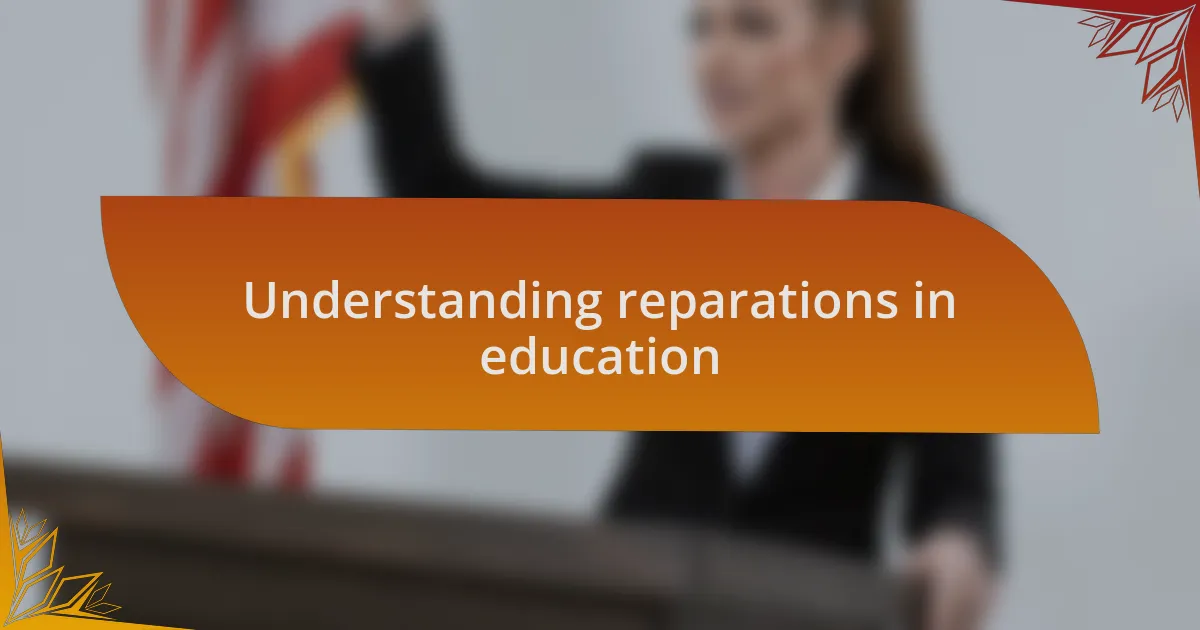
Understanding reparations in education
Reparations in education often involve acknowledging and addressing the historical injustices faced by marginalized communities. I remember a discussion I had with a teacher who shared how funding disparities had impacted her students over the years. It made me realize that reparations are not just about financial compensation; they are about correcting systemic inequities that have persisted for far too long.
When I think about the implications of reparations, I often wonder how society measures value in education. Is it purely financial, or does it encompass the cultural and emotional needs of students? In my experience, educational equity is essential for nurturing a generation that thrives, and this requires a deep, honest reflection on how we support all learners, especially those who have been historically denied resources and opportunities.
The concept of reparations can also be a powerful tool for community empowerment. I once facilitated a workshop where we explored strategies to include diverse voices in curriculum development. It was eye-opening to see how community engagement can redefine educational narratives and inspire students. Ultimately, reparations in education is not just a policy debate; it’s about creating spaces where every student can excel and feel valued.

Historical context of reparations
When examining the historical context of reparations, it’s vital to recognize that this idea isn’t new. Many nations have grappled with the consequences of their colonial pasts, with reparations emerging as a means to address the wounds inflicted on oppressed communities. I remember reading about the post-Civil War era in the U.S., where the promise of “40 acres and a mule” was a fleeting hope for freed slaves—a promise unfulfilled that has echoes still felt today.
Throughout history, various groups have advocated for reparations as a way to rectify the injustices of slavery and systemic racism. This isn’t merely a historical footnote; it’s a living conversation that resonates deeply with current discussions on equity and access. Reflecting on this, I wonder how many more stories of resilience and struggle we need to confront before meaningful reparations are realized in modern education systems.
Moreover, the concept of reparations extends beyond financial settlements; it can include structural changes in schooling systems that honor the histories and cultures of marginalized groups. I recall attending a community meeting where the discussion focused on integrating African American history into the curriculum as a form of reparative justice. This collective effort illuminated how education can be an avenue for healing and truth-telling, laying the groundwork for a future where everyone is seen and respected.
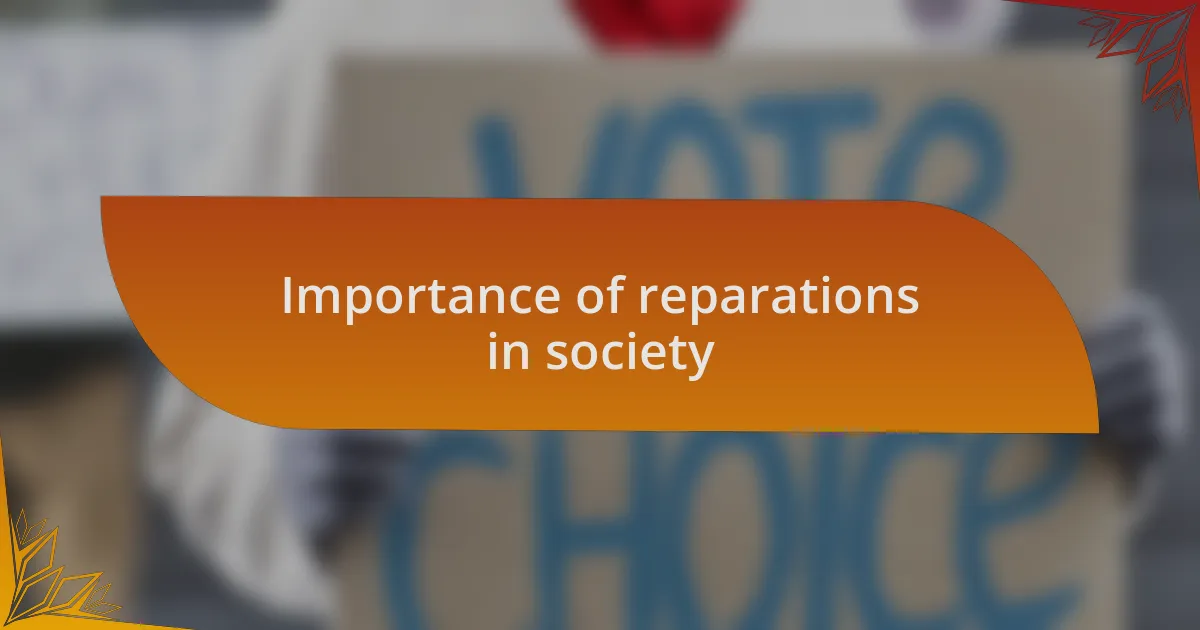
Importance of reparations in society
Reparations in society serve as a necessary acknowledgment of past injustices. When communities receive reparative support, it often fosters healing by addressing historical grievances—something I have noticed during discussions in my own community. People often express that recognizing their struggles, be it through reparations in education or other means, empowers them to move forward with hope and agency.
The importance of reparations goes deeper than simple accountability; it can transform educational spaces into platforms of inclusivity. For instance, I once attended a seminar where educators shared how integrating diverse perspectives into their curricula not only enriched the classroom but also instilled a sense of belonging among students from marginalized backgrounds. Isn’t it powerful to think that education can facilitate reparative actions that empower future generations?
In my experience, the ripple effects of reparations extend beyond individual benefits; they can reshape societal norms. When we engage in conversations about reparative justice, it opens doors to broader discussions about equity and justice. I often find myself pondering how a society that takes reparations seriously could better understand and address systemic inequalities, ultimately leading to a more harmonious community.
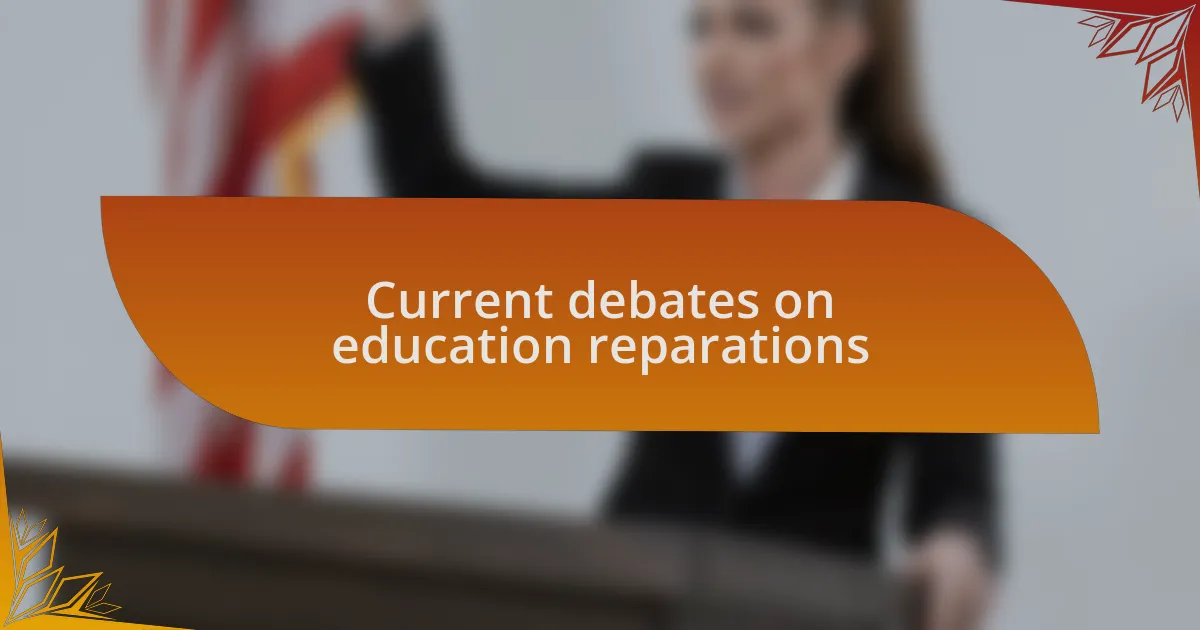
Current debates on education reparations
The debate surrounding educational reparations is dynamic and multifaceted, and it often centers on how to best implement these initiatives. Recently, conversations have arisen about whether to allocate funds directly to schools serving marginalized communities or to provide targeted scholarships for students. Reflecting on my own educational journey, I wonder how differently my path might have looked if I had access to resources specifically designed to support underrepresented students.
Some argue that education reparations could lead to a sense of entitlement, sparking fears of backlash from various community segments. I must admit, I’ve felt the tension when discussing this topic with friends who believe that reparations might stigmatize recipients rather than empower them. It really makes me think: How can we communicate the value of reparations in education as a bridge toward equality, rather than a divisive tool?
Another critical aspect of the debate is the role of affirmative action and its perceived implications on meritocracy. I remember a heated discussion I had with a colleague who insisted that merit should solely dictate educational opportunities. As I shared my perspective that reparations aim to level the playing field rather than diminish achievements, I realized the importance of transforming these conversations into opportunities for growth. Isn’t it essential to find common ground?
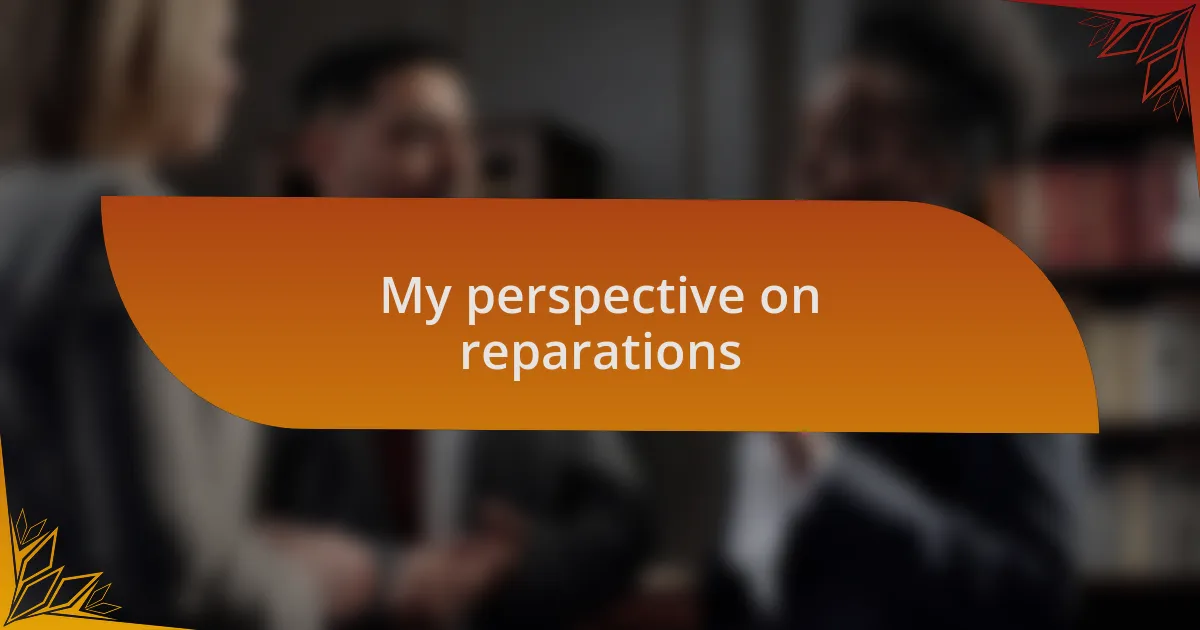
My perspective on reparations
My perspective on reparations emphasizes the importance of acknowledgment and action. Growing up, I often felt the weight of imbalance in educational resources, as if some doors were simply closed to me and my peers. If reparations in education can help open those doors for future generations, then I believe they’re a necessary step toward justice.
In my discussions, I’ve noticed that some people view reparations as a threat to hard work and achievement. This perspective frustrates me, as I remember working diligently in a system that didn’t always reward effort equally. It makes me question: how can we shift this narrative to show that supporting those who’ve been historically marginalized doesn’t undermine anyone’s achievements, but instead enriches our collective future?
When we talk about reparations, I often think about my own support system during school. What if we could create an educational environment where every child has a mentor dedicated to their success, regardless of their background? That vision of empowerment resonates deeply with me. It underscores the idea that reparations in education could not only heal wounds but also nurture a diverse array of talent that benefits society as a whole.
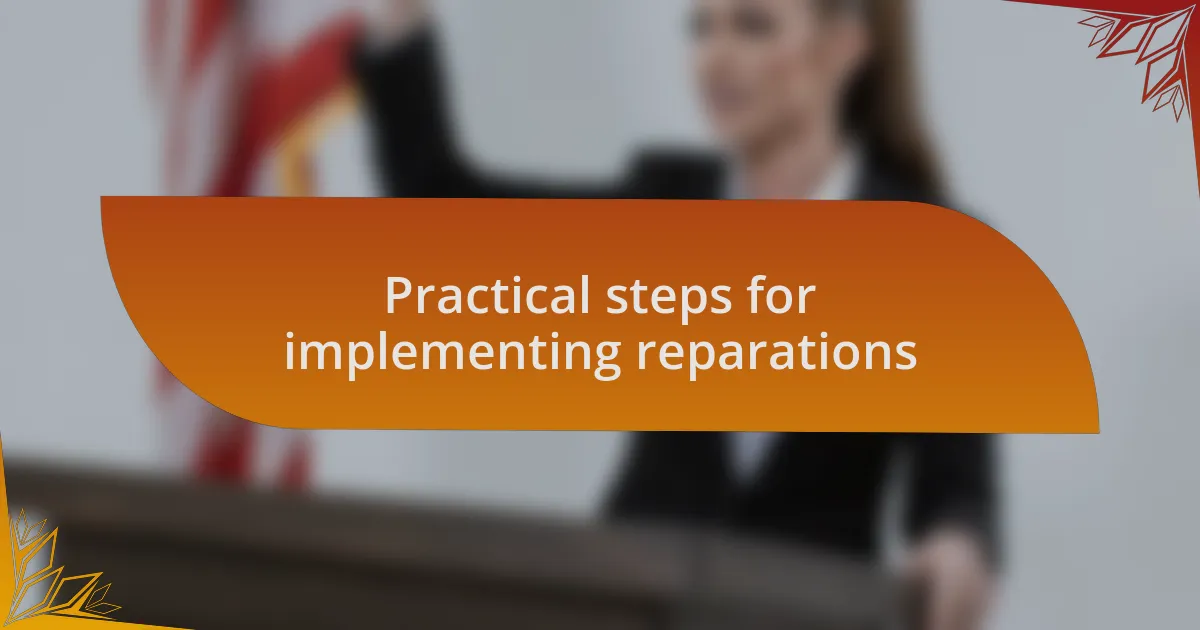
Practical steps for implementing reparations
Implementing reparations in education is a nuanced task, but I believe targeted funding for schools in historically marginalized communities is a critical first step. Imagine what those resources could achieve: updated facilities, sufficient educational materials, and trained staff who are equipped to nurture every student’s potential. I can’t help but think of my friend who struggled with science due to outdated textbooks—the difference such funding could have made for her future is truly profound.
Another important step could be the integration of community involvement in educational decision-making. When I reflect on my own schooling, I remember how parents and guardians often felt left out of the conversation. What if we established local councils that included community voices? It’s about creating a system that reflects the needs and aspirations of the community, which, in turn, would foster a greater sense of ownership and investment in education.
Lastly, I see the potential for reparations through programs that focus on restorative justice in schools. These initiatives would not only address past injustices but also cultivate healing environments. What if schools implemented sessions that encouraged dialogue about race and inequity? Based on my experience, such conversations can lead to deeper understanding and collaboration among students, creating a more empathetic generation ready to tackle societal issues together.
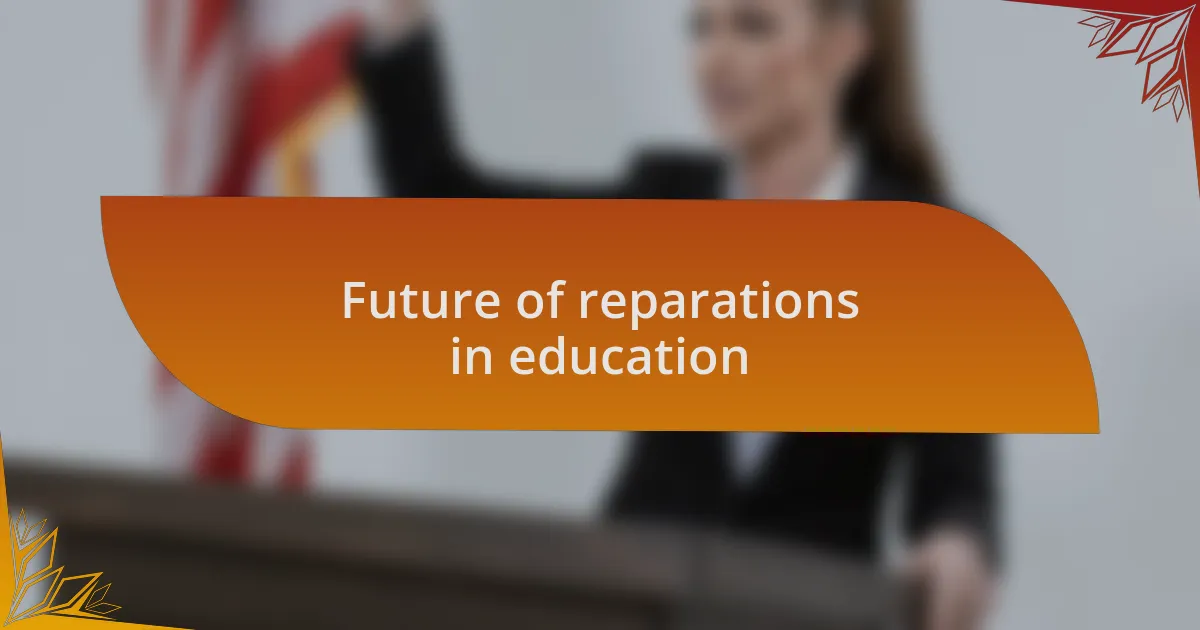
Future of reparations in education
As I look ahead, I envision a future where reparations in education not only reshape curriculums but also transform the very concept of learning itself. Schools could become vibrant hubs of cultural exchange, providing students with experiences that reflect their histories and diverse backgrounds. Have you ever felt disconnected from what you were studying? Imagine a classroom where every child sees their identity validated and celebrated—what a difference that could make!
Furthermore, the future could see innovative scholarship programs that are designed specifically for underrepresented students. I recall a classmate whose dreams of college felt out of reach due to financial constraints, even though she had the talent and drive. Targeted scholarships could not only empower students to pursue higher education but also mitigate the long-standing economic disparities that hinder their success.
Moreover, ongoing collaboration between educational institutions and local governments could pave the way for more comprehensive policies that address the root causes of inequity. I often think about how initiatives, such as mentorship programs involving successful alumni from marginalized communities, could inspire current students. Wouldn’t it be impactful to have relatable role models guiding them? Creating pathways to success illustrates a commitment to a more equitable future—one where every student is afforded the opportunity to thrive.